| HOME |
|---|
ORION
The Hunter
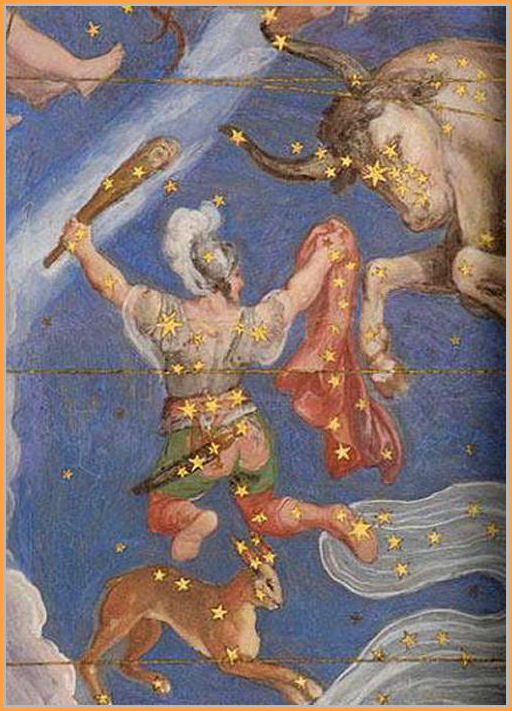
Ceiling Frescoe, Villa Farnese - MAP OF THE HEAVENS - Giovanni Antonio da Varese - 1575
| HOME |
|---|

There is surely no finer way to begin a tour of the constellations than with the magnificent Orion. In the crisp, invigorating air of a winter night, direct your gaze high in the southern sky, and look for the three bright stars in a row that mark Orion's belt. They are unmistakable, and will quickly catch your eye. From there, you can't miss the large orange Betelgeuse (BEE-tel-joos) up by Orion's shoulder, and the bright blue/white Rigel (RY-jel) down by his foot. Then the giant form of Orion will suddenly appear before you, the sky will come alive right before your eyes, and your journey through the cosmos has begun.
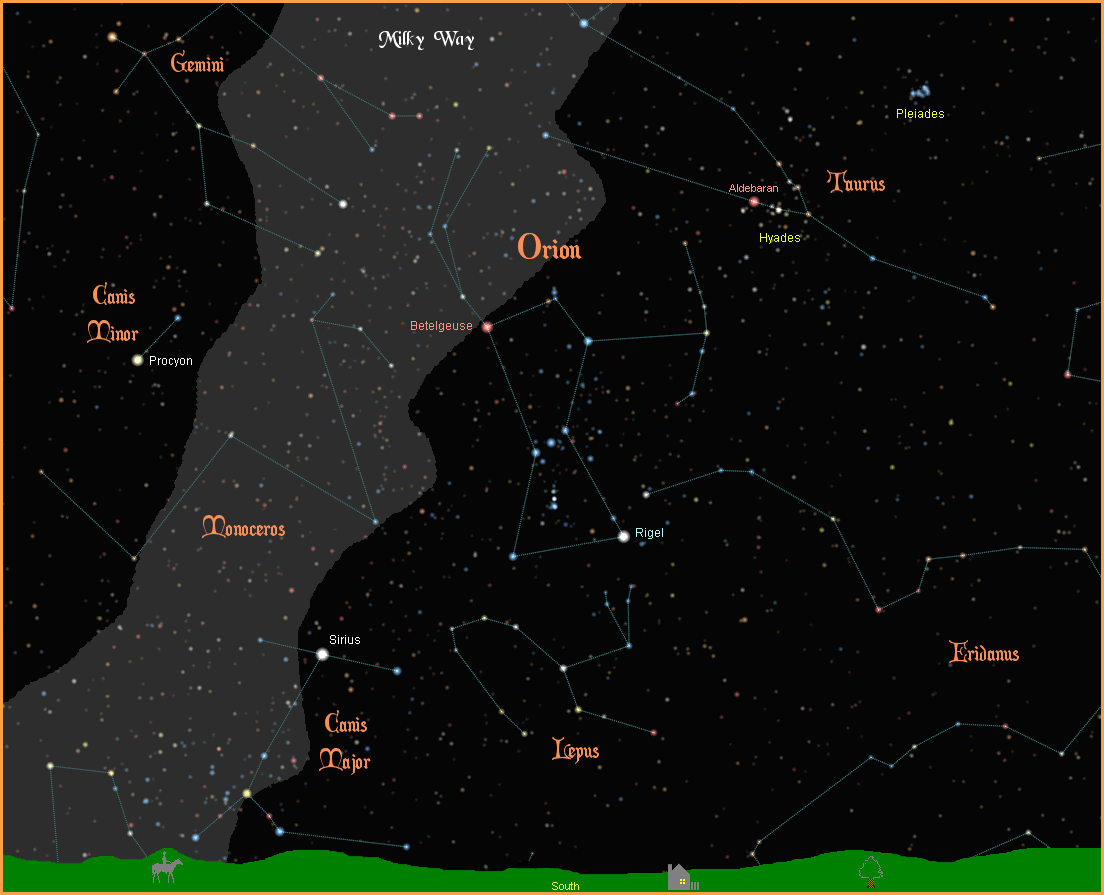
In Greek legend the infant Orion was a gift from the gods to the widower Irieus, as a reward for his generous nature. Orion grew into an impressive figure of a man and an exceptional hunter. Robert Graves describes him as "the most handsome man alive". Homer called him "the tallest and most beautiful of men".
When he wasn't hunting, Orion was chasing women. He pursued and pressed his attentions on all the sisters Pleiades, as well as the sisters Hyades, who all fled his advances. Finally, he managed to win the love of the famed huntress Diana (Artemis). Unfortunately, Diana's overly protective brother, Apollo, sent a giant scorpion to sting Orion, and kill him. Some myths say the scorpion killed the mighty Orion, while others say he avoided the scorpion, only to have Apollo trick Diana into shooting Orion with an arrow and killing him.
Diana had Orion's image placed in the sky, accompanied by the hare, Lepus, and his two hunting dogs, Canis Major, and Canis Minor. The sisters Pleiades and Hyades were placed just beyond Orion's reach, for him to forever chase across the sky, and the deadly scorpion was positioned on the opposite side of the heavens, so it could never threaten Orion again. By the banks of the river Eridanus, with a wild hare at his feet and his hunting dogs by his side, Orion forever faces the horns and baleful red eye of Taurus, the bull.
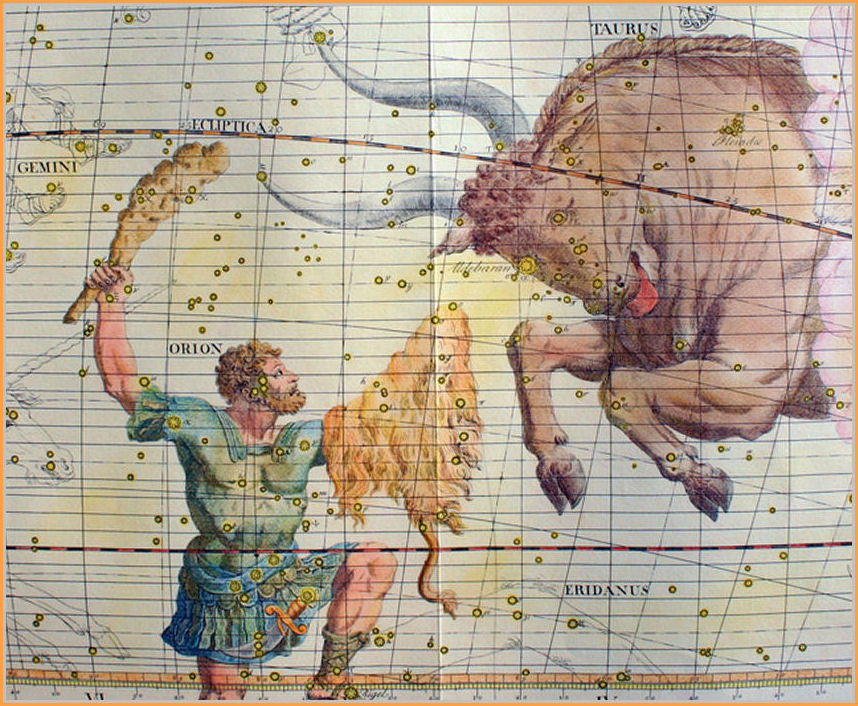
The brightness of stars and other celestial objects is measured in terms of magnitude. In contrast to most other scales, with celestial magnitude the smaller the number, the brighter the object, with the very brightest objects having negative magnitudes. Sirius, for example, the brightest star in the night sky, has a magnitude of -1.42. The magnitude system is ancient, devised by the Greek astronomer Hipparchus around 129 B.C., who categorized the brightest stars as "first magnitude" and the dimmest stars he could see as "sixth magnitude".
There are two types of magnitudes. Absolute magnitude is the brightness of an object viewed from a standard distance of 10 parsecs (32.6 light years). Apparent magnitude is the brightness of an object viewed from Earth, regardless of its distance. A relatively dim star close to Earth may appear much brighter than a relatively bright star farther away, so a star's absolute magnitude is usually very different from its apparent magnitude. Absolute magnitude is rarely used outside of technical papers and characterized with a capital "M". Apparent magnitude is the default, common reference used almost everywhere, spelled with the standard lower case "m".
Just as in the time of Hipparchus, the naked eye can usually see objects down to about sixth magnitude. Small telescopes up to six inches can usually resolve objects down to about eleventh magnitude. Beyond that you need the power of a large telescope.
The star designated Alpha Orionis is named Betelgeuse, Arabic for arm of the giant. But the real giant is Betelgeuse itself. Formally classified as an M2I red supergiant, Betelgeuse has a diameter over 800 times larger than our Sun. As shown by the Hubble Space Telescope photo below, if Betelgeuse replaced the Sun at the centre of our solar system, its surface would be out by the orbit of Jupiter! It is so large it takes four years to rotate once on its axis. Fortunately for us, Betelgeuse is very far away, out at a safe distance of 520 light years. Despite its great distance and a low surface temperature of only 3,450 degrees K, its enormous size causes it to shine in our sky with a magnitude of 0.58, making it the second brightest star in the constellation, and the tenth brightest star in the entire sky.
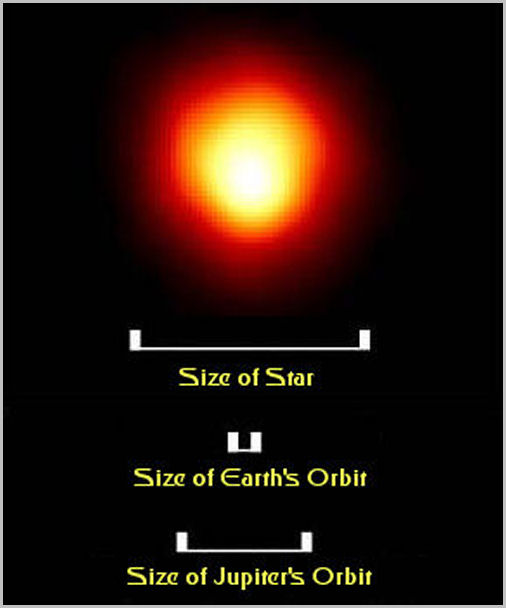
The beta star in Orion is Rigel, from the Arabic "Rijl Jauzah al Yusra", the left leg of the giant. It is a B8I blue/white supergiant, nowhere near the size of Betelgeuse, but still 68 times the diameter of our Sun. Being a blazing white-hot young star, it is much hotter and brighter than Betelgeuse, with a surface temperature of 11,200 degrees K, and even though it is much farther away at 860 light years, it still outshines Betelgeuse with a magnitude of 0.12, making it the brightest star in the constellation and the seventh brightest star in the entire sky. Rigel has a much fainter companion star, Rigel B, which has a magnitude of only 6.7, and although they appear close together from our perspective, the two stars are over 200 billion miles apart, and take 25,000 years to orbit each other. Modern spectroscopy has revealed that Rigel B is itself a double or binary system, consisting of two very close stars that orbit each other every 10 days, making Rigel a triple star system.
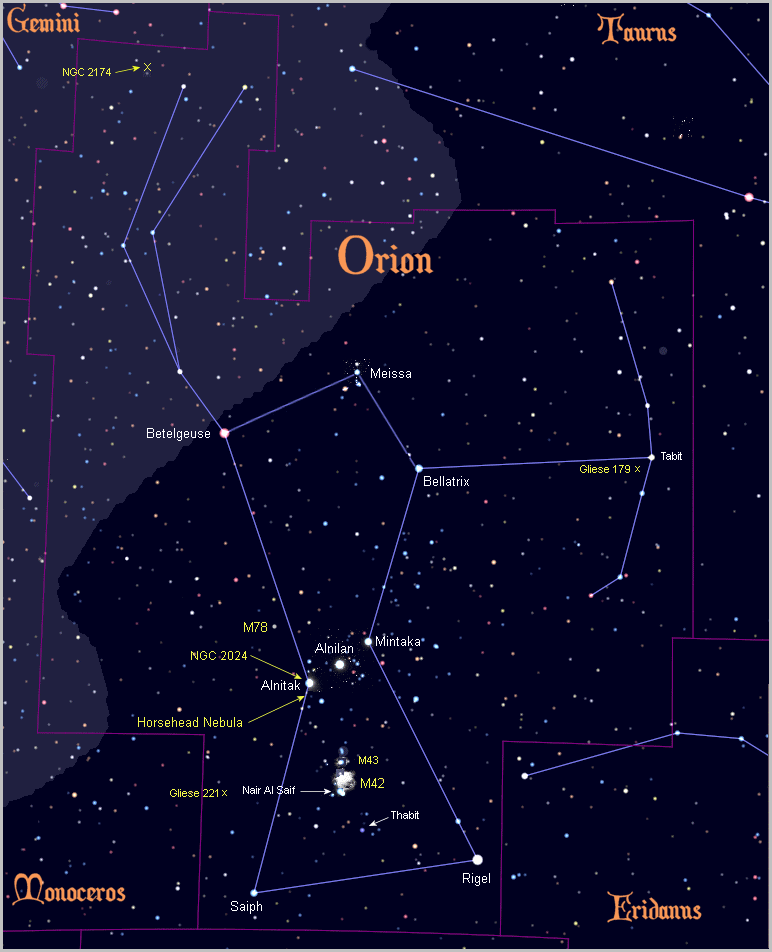
Gamma Orionis is the third brightest star in Orion, named Bellatrix, Latin for female warrior, and often referred to as The Amazon Star. It is a B2III blue giant with a magnitude of 1.64, about 250 light years away. Like all blue stars it is very hot, with a surface temperature of 22,000 degrees K.
Delta Orionis is Mintaka, the Arabic word for belt, as it is the westernmost of the three stars that make up the famous belt of Orion. It is a complicated quadruple star system, starting off with a very hot B0III blue giant, surface temperature 30,000 degrees K, and a similar O9V blue main sequence star estimated to be even hotter. These two super hot stars are so close they orbit each other every 5.73 days. Around this seething central monstrosity of heat and powerful gravitational waves orbit two much smaller, dimmer companions, all four stars shining with a combined magnitude of 2.25, out at the very great distance (fortunately) of 915 light years from Earth.
Epsilon Orionis is the central star in Orion's belt, appropriately named Alnilam, Arabic for string of pearls. It is another very large, very hot star, a B0I blue supergiant with a surface temperature of 25,000 degrees K. At magnitude 1.69 it is the brightest star in Orion's belt even though it is the farthest away at a distance of 1,340 light years. The star is so hot it lights up the surrounding interstellar gas, making its own reflection nebula labelled NGC 1990.
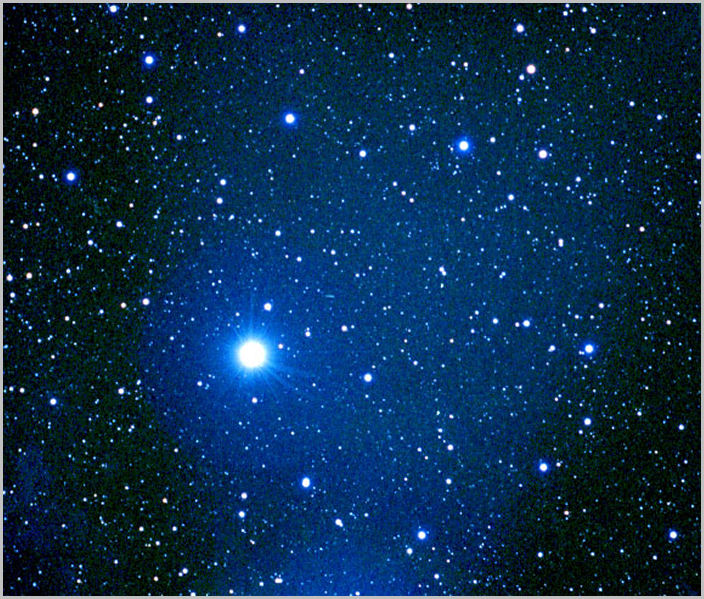
The eastern star in Orion's belt is Zeta Orionis, named Alnitak, Arabic for the girdle. Like the other two stars in Orion's belt it is very large, very hot, and very far away: an O9I blue supergiant with a surface temperature of 31,000 degrees K. It has two smaller, dimmer companions, making it a triple star system with a combined magnitude of 1.74, located about 800 light years away.
And the big, bad, far away blue stars keep coming with Kappa Orionis, named Saiph, from the Arabic for sword of the giant, even though it's in Orion's right foot. It is a B0II bright giant with a magnitude of 2.06, about 760 light years away.
Properly hanging from Orion's belt is Nair Al Saif, the bright one of the sword. It is a quadruple system, very similar to Mintaka: a B0III blue giant, and an O9III blue giant locked in a tight embrace, circling each other every 29 days, and two smaller, dimmer companions orbiting the massive binaries. As with all the named star systems in Orion, Nair Al Saif is very far away, at a distance of about 1,300 light years, shining with a combined magnitude of 2.77.
Upsilon Orionis is a small, dim little star near the bottom of the figure that is not little at all, but actually a very large O8V blue main sequence star with a mass 30 times greater than our Sun. It appears so small and dim because it is very, very far away at a distance of about 3,000 light years, so despite having a searing surface temperature of 34,000 degrees K, and a luminosity at least 60,000 times greater than our Sun, it appears in our sky with the lowly magnitude of 4.62. Why the ancients named this faint star is a mystery. It carries the name Thabit, which R.H. Allen tells us is Arabic for the endurer, though he is unable to derive its origins.
To further confuse us, the star Pi3 Orionis has the same name, albeit differently spelled as Tabit. This star at least is a bit more visually impressive at magnitude 3.19, being the brightest of the curving column of stars depicting the lion skin Orion traditionally holds in his left hand. Significantly, this star is very different from all the other eleven named stars in Orion, which have all been massive, super hot blue stars many hundreds of light years away. This star is an F6V yellow main sequence star with a nice, normal surface temperature of 6,700 degrees K, very similar to our Sun. What's more, this star is very close, only 26 light years away. Its proximity and Sun-like qualities mean a lot of telescopes have it in their sights, looking for planets and possible indications of life.
Representing the head of Orion is Lambda Orionis, named Meissa, from the Arabic for the shining one. It is another sizzling hot O8III blue giant, with a surface temperature of 37,000 degrees K (compared with our Sun at 6,000 degrees K). At a distance of about 1,000 light years, its light reaches us with a magnitude of 3.39. Meissa is the brightest of a star cluster named Collinder 69, and the combined energy of these stars has ionized a huge ring of interstellar gas around them called the Lambda Orionis Molecular Ring (SH 2-264). Not much to see in visible light, the nebula puts on quite a show in the infrared spectrum. Through the eyes of NASA's WISE infrared telescope red stars turn blue, blue stars turn red, and the surrounding emission nebula is a spectacular glowing green circle a staggering 150 light years across. At bottom left is the normally red Betelgeuse, in the centre is Meissa, and over on the right side is the normally blue Bellatrix.
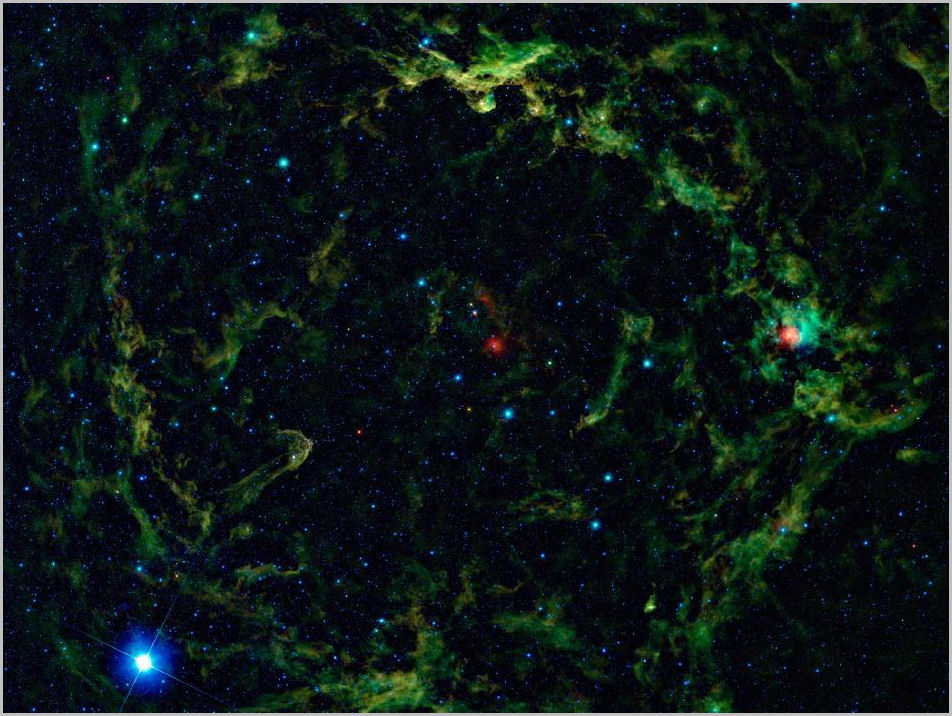
So far, eight planetary systems have been discovered within the boundaries of the Orion constellation, the closest of which is Gliese 179, only 39 light years away. The star is an M4V red main sequence star with a surface temperature of only 3,370 degrees K, making it far too faint to see at magnitude 11.96. There is one confirmed planet in the system with 0.82 times the mass of Jupiter. An orbital radius of 2.41 AU would put the planet inside the asteroid belt of our solar system, and it takes 2,288 days to complete one orbit around its star.
Farther away at 66 light years is the Gliese 221 system (also designated BD-06 1339), with two known planets so far. The dim, magnitude 9.7 star is a K3V orange main sequence star with a surface temperature of 4,040 degrees K. Planet Gliese 221 b is about the size of Neptune, in a 125 day orbit, 42 million miles (67 million kms) from the star. Planet Gliese 221 c is a super earth, 6.2 times the size of Earth. It's in an extremely close 4 day orbit, only 4 million miles (6.4 million kms) from the star, making it far too hot and hostile for much prospect of life.
The remaining 6 planetary systems are all very far away and too dim to see, with large, gas giant planets. For more information on these and other extrasolar planets, visit NASA's New Worlds Atlas, and The Open Exoplanets Catalogue.
You never forget the first time you see The Great Orion Nebula through a telescope. In a backyard scope it has a faint greenish glow about it, looking like a giant bat, or manta ray, or some great ghostly bird of prey with huge back-swept wings, swooping down from the sky. It is, in fact, an immense cloud of gas and dust 1,900 light years away, in which stars are being born. The Orion Nebula is one of the largest star forming nebulae known, spanning 30 light years across.

One of the most famous features in Orion is invisible to the naked eye and to most telescopes. But with long time exposures and special filters, the iconic dark nebula with the unique shape of a horsehead appears. The Horsehead Nebula, also known as Barnard 33, is embedded within the much larger emission nebula, IC 434. The Hubble Space Telescope image of the Horsehead Nebula below reflects the poetry of Robert Burnham Jr., who described it as "irresistibly conjuring up surrealistic visions of a cosmic chess game."
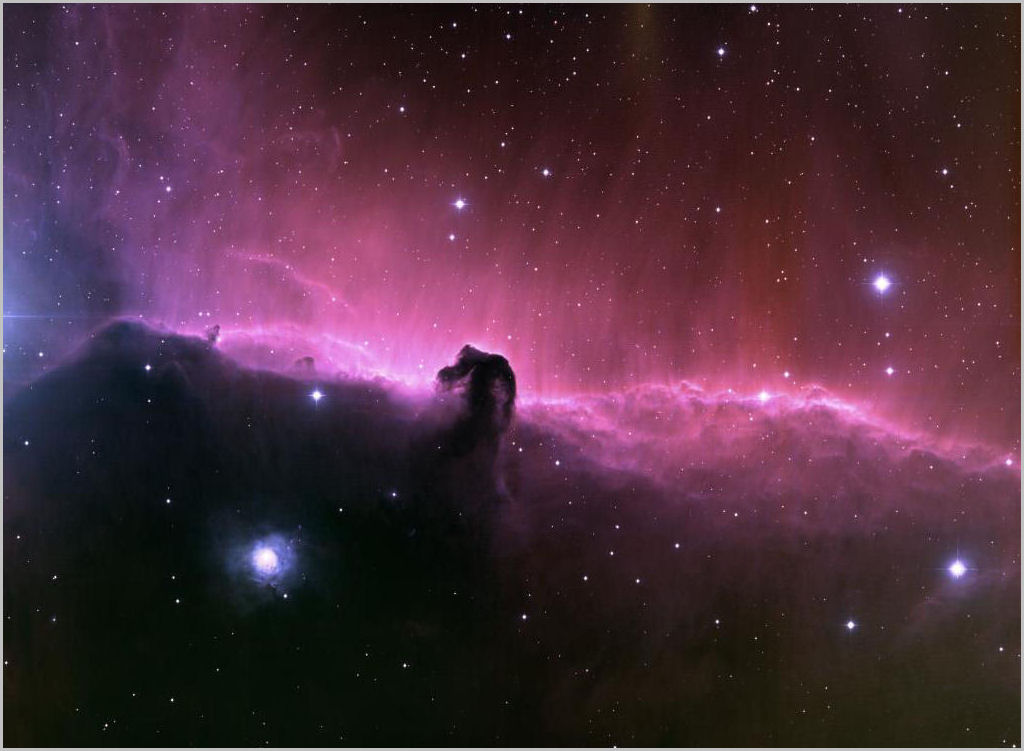
M78 (NGC 2068) is a reflection nebula with a magnitude of 8.3, 1,600 light years away. It consists of clouds of mostly hydrogen gas, lit up with the reflected light of stars HD 38563A and HD 38563B.
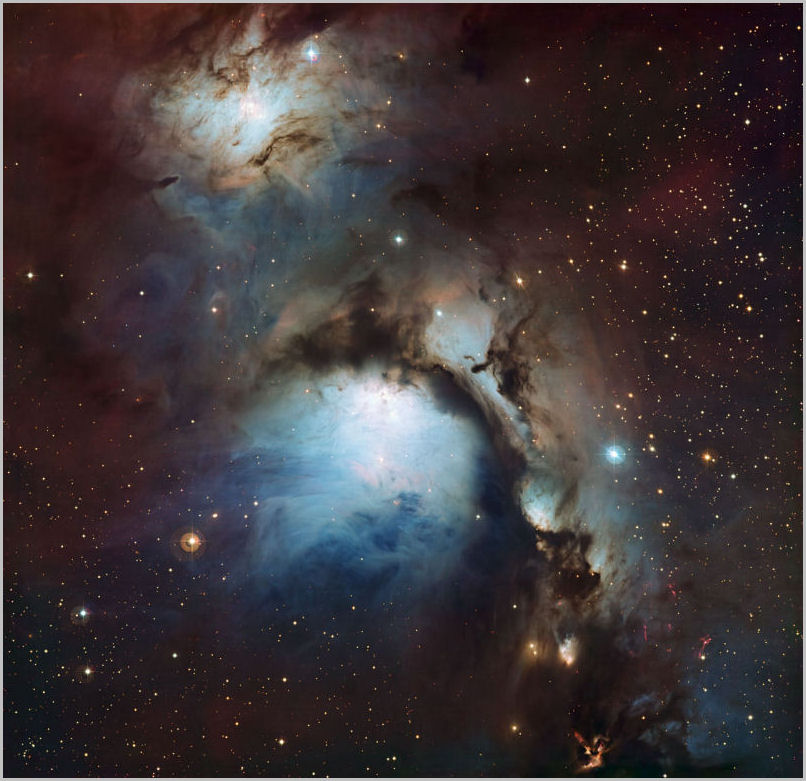
NGC 2024, also known as The Flame Nebula, is an emission nebula in which vast clouds of hydrogen gas have been ionized by the energy of the star Alnitak in Orion's belt. Although the nebula has a bright magnitude of 2.0, it is difficult to see in the overpowering glare of Alnitak, right beside it. The nebula is 1,500 light years away.

Up in the top corner of the constellation is NGC 2174, The Monkey Head Nebula. It is another emission nebula, the hydrogen gas being ionized by the star cluster NGC 2175 embedded in the center of the nebula. The left image below is a visible light image of the entire nebula, with the monkey's big brown ear, and bright eye looking off to the left. On the right is a close-up of the insert captured in infrared. Like most nebulae, it is difficult to detect without filters and time exposures.
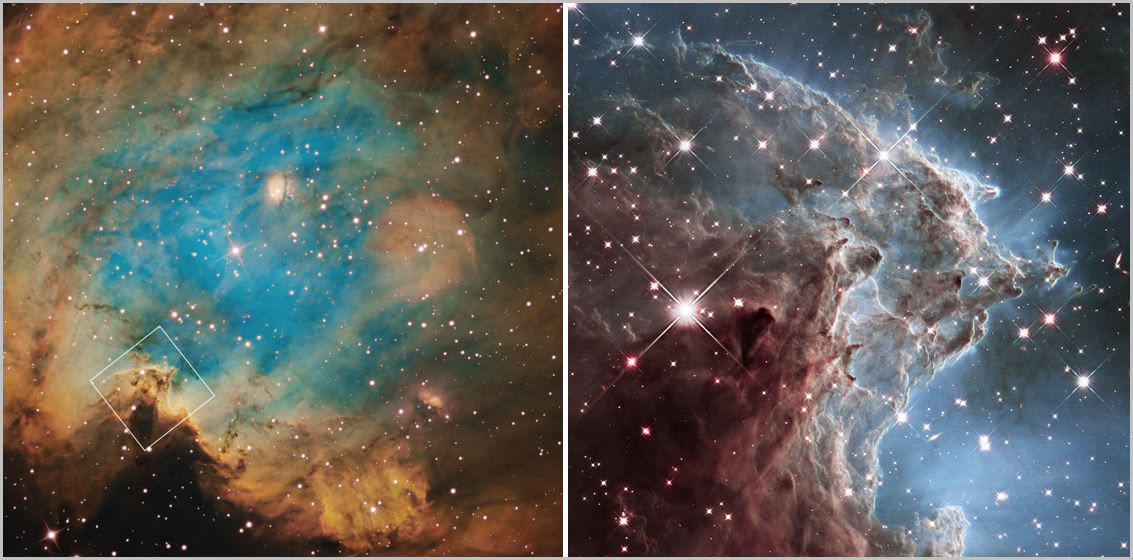
|
|
|
|
|
|